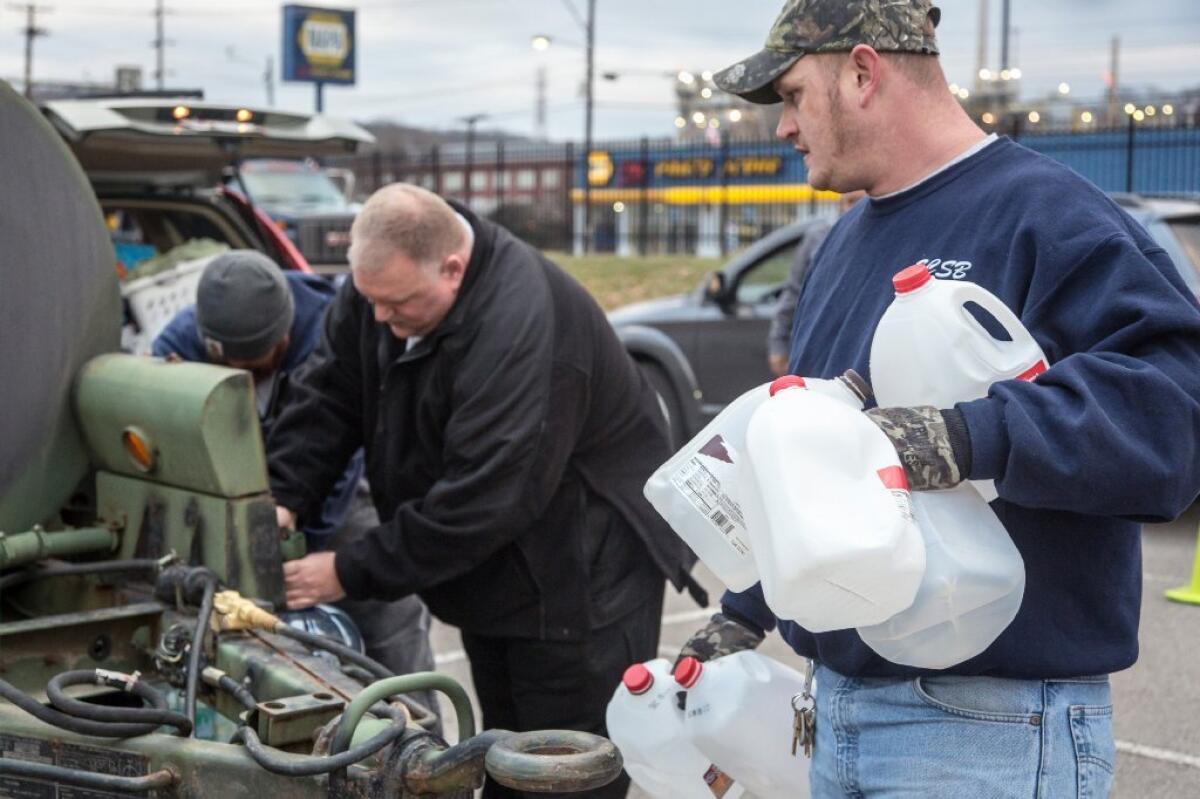Many reported sickened after West Virginia chemical spill, survey says

- Share via
When a storage tank spilled an obscure coal-cleaning chemical into the water supply in West Virginia in January, officials ultimately told 300,000 people not to use the water.
Charleston was the largest city affected, as well as the source of the spill. And according to a recent survey of about 500 people in the area, a third of the respondents said someone in their household became sick after their water was contaminated.
The release of the Kanahwa County report last week renewed calls for research on the long-term health effects of the little-known chemical that leaked out of a storage tank into the Elk River and lent the area’s drinking water a licorice odor.
For days after the Jan. 9 spill, West Virginians across nine counties were told not to drink or use the water because the short-term health effects of 4-methylcyclohexane methanol were unknown.
It is not known how many people in the nine counties were sickened by the chemical or whether it could cause cancer. The new study shows that in the Charleston area many residents used potentially contaminated water during the crisis.
Despite the warnings, about a quarter of the 500 respondents said they had used the water for drinking, showering and other personal tasks during the do-not-use order. The survey was conducted by the Kanawha-Charleston Health Department and other health experts.
Rashes and skin irritation were the most common symptoms for those sickened, with diarrhea, vomiting, dizziness and other symptoms also reported.
Even after the do-not-use order was lifted several days after the spill -- with officials developing an elaborate “flushing” process to clean the contaminant from sinks and pipes -- traces of the chemical were detected in the water supply through March.
Additionally, about 40% of those sickened reported their first symptoms after the do-not-use order was lifted, according to the survey.
Dr. Rahul Gupta, director of Kanawha-Charleston Health Department, said there continued to be several complaints about contaminated water in the months after the spill, with schools in particular often needing to be flushed several times.
“The plumbing system is a complex system, we’ve learned the hard way,” Gupta told the Los Angeles Times on Wednesday. “Sometimes what’s conceivable to happen is the flushing process may not have taken care of the school system’s flushing in one go.”
“People are still not drinking the water,” he added, noting that the survey, which was conducted in early April, showed that fewer than 40% of the respondents were using the water to drink or give to their pets. Fewer than 10% of respondents called the water “safe.”
Gupta hoped there would be federal funding to set up a study of the population to see whether the chemical has any long-term effects.
This week, area activists also released a report saying that jail officials denied hundreds of inmates access to sufficient clean water in the days after the spill and failed to rigorously cleanse the water.
Multiple inmates in the South Central Regional Jail in Charleston reported getting sick after officials gave them as few as two bottles of water a day after the spill, forcing inmates to choose between dehydration or drinking contaminated water, according to volunteers who interviewed inmates and who posted their findings online.
The jail’s water conditions were also reported in a lengthy investigation published Wednesday by the liberal news site ThinkProgress.
“I was just extremely exhausted,” inmate Eric Ayers told ThinkProgress of the period when he didn’t have clean water. “I got headaches, felt like I couldn’t do anything. My urine was dark yellow, almost orange.”
After jail officials stopped providing bottled water eight days after the spill, a former inmate, Terry Davis, told the website that the jail’s drinking water continued to have an odor through March. “The water was still bad, but they said it wasn’t,” Davis said. “It had the smell, like licorice. It was nasty.”
Spokespeople for the West Virginia Jail and Correctional Facility Authority and the West Virginia Bureau for Public Health did not respond to messages left Wednesday afternoon seeking comment on the jail’s conditions.
More to Read
Sign up for Essential California
The most important California stories and recommendations in your inbox every morning.
You may occasionally receive promotional content from the Los Angeles Times.














